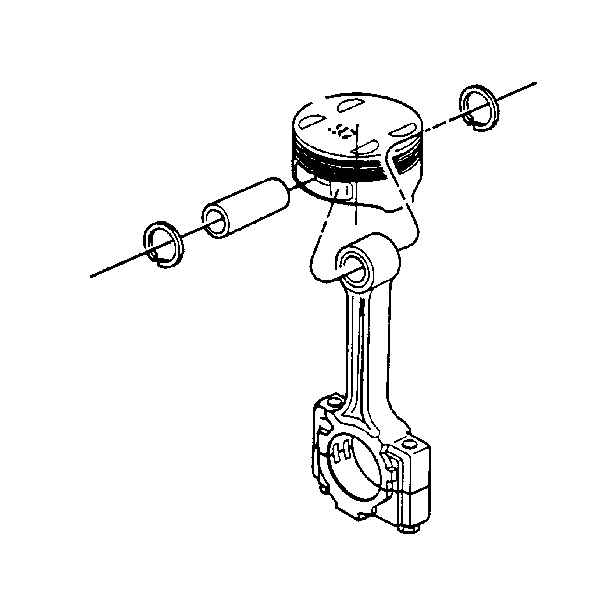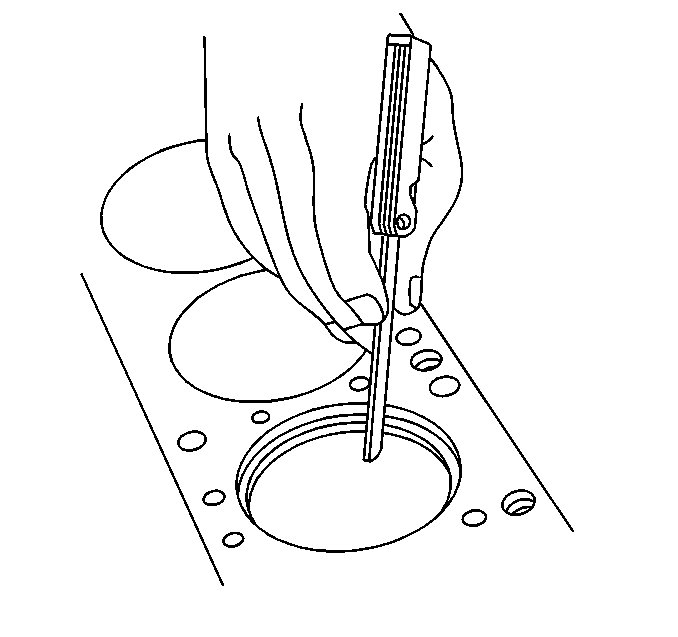For 1990-2009 cars only
- Clean the piston skirts and the pins with a cleaning solvent. DO NOT wire brush any part of the piston.
- Clean the piston ring grooves with a groove cleaner. Make sure oil ring holes and slots are clean.
- Inspect the pistons for the following conditions:
- Replace pistons that show any signs or damage or excessive wear.
- Measure the piston pin bore to piston pin clearances using the following procedure:
- Measure the piston ring end gap using the following procedure:
- Measure the piston ring side clearance using the following procedure:
- When replacing the piston rings, only install re-ring sets that have a 1.2 mm thick nitrided steel upper compression ring and multi-piece oil rings. The top compression ring may be installed with either side up. There is a locating dimple on the 2nd compression ring near the end for identification of the top side. Install the 2nd compression ring with the dimple facing up.
- If the new ring does not reduce the clearance to 0.04 mm (0.002 in.) or less, install a new piston.
- Measure piston width using the following procedure:
- If the clearance obtained through measurement is greater than these specifications and the cylinder bores are within specification, replace the piston.

| • | Cracked ring lands, skirts, or pin bosses |
| • | Ring grooves for nicks, burrs that may cause binding |
| • | Warped or worn ring lands |
| • | Piston pin retainer grooves for burrs |
| • | Scuffed or damaged skirts |
| • | Eroded areas at the top of the piston |
| • | Worn piston pin bores or worn piston pins |
| 5.1. | Piston pin bores and pins must be free of varnish or scuffing. |
| 5.2. | Use an outside micrometer to measure the piston pin in the piston contact areas. |
| 5.3. | Using an inside micrometer, measure the piston pin bore. |
| 5.4. | Subtract the measurement of the piston pin bore from the piston pin. The clearance should not exceed 0.002-0.013 mm (0.0001-0.0005 in). |
| 5.5. | If the clearance is excessive, determine which piece is out of specification. |

| 6.1. | Place the piston ring in the area of the bore where the piston ring will travel (approximately 25 mm or 1 inch down from the deck surface). Be sure the ring is square with the cylinder bore by positioning the ring with the piston head. |
| 6.2. | Measure the end gap of the piston ring with feeler gages. Compare the measurements with those provided below: |
| • | The top compression ring end gap should be 0.25-0.40 mm (0.010-0.016 in). |
| • | The second compression ring end gap should be 0.35-0.50 mm (0.014-0.020 in). |
| • | The oil ring end gap should be 0.25-0.76 mm (0.010-0.030 in). |
| 6.3. | If the clearance exceeds the provided specifications, the piston rings must be replaced. |
| 6.4. | Repeat the procedure for all the piston rings. |

| 7.1. | Roll the piston ring entirely around the piston ring groove. If any binding is caused by the ring groove, dress the groove with a fine file. If any binding is caused by a distorted piston ring, replace the ring. |
| 7.2. | With the piston ring on the piston, use feeler gages to check clearance at multiple locations. |
| 7.3. | The clearance between the surface of the piston ring and the ring land should be no greater than 0.095 mm (0.004 in). |
| 7.4. | If the clearance is greater than specifications, replace the piston rings. |

| 10.1. | Using an outside micrometer, measure the width of the piston 50 mm below the crown (top) of the piston at the thrust surface which is perpendicular to the centerline of the piston pin. |
| 10.2. | Compare the measurement of the piston to its original cylinder by subtracting the piston width from the cylinder diameter. |
| 10.3. | The proper clearance specification for the piston is 0.020-0.051 mm (0.0007-0.00020 in). |
